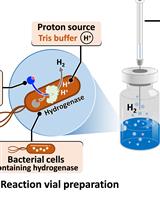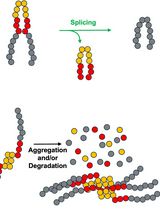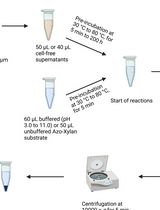- EN - English
- CN - 中文
Single Cell Flow Cytometry Assay for Peptide Uptake by Bacteria
采用单细胞流式细胞术测定细菌的肽吸收
(*contributed equally to this work) 发布: 2016年12月05日第6卷第23期 DOI: 10.21769/BioProtoc.2038 浏览次数: 14042
评审: Zhaohui LiuLior LobelAnonymous reviewer(s)
Abstract
Antimicrobial peptides (AMPs) can target the bacterial envelope or alternatively have intracellular targets. The latter requires uptake of the peptide by the bacterial cells. The bacterial internalization of an AMP can be evaluated by a fluorescence-based method that couples the use of the fluorescently labelled AMP to the fluorescence quencher trypan blue. Trypan blue is excluded from the interior of intact cells and the fluorescence of the extracellular peptide or of the peptide bound on the bacterial surface can be quenched by it, while the fluorescence of the internalized peptide is not affected. The uptake of the peptide by the bacteria is determined by measuring the fluorescence in individual cells by flow cytometry.
Keywords: Antimicrobial peptide (抗菌肽)Background
AMPs consist of a broad and diverse class of potent antimicrobials that have potential as novel therapeutic agents (Wang et al., 2015). AMPs are part of innate immunity and are produced by organisms of all kingdoms. They are mobilized by these organisms to fight infecting microbes, that can be either bacteria, fungi or viruses. They do so by directly killing the microbes, but they can also act as sentinels that alert other immune pathways. Interestingly, it has also become clear that AMPs are not only agents against bad microbes, but that they also have key roles in the control of symbiotic bacterial populations in animal and plant hosts (Maróti et al., 2011; Kondorosi et al., 2013).
The diversity of AMPs in sequence and structure is so large that it is difficult to classify them. Moreover, AMPs of different origin have also highly diverse modes of action. They can be broadly divided in peptides that target the bacterial envelope, destroying its cell barrier function by permeabilizing cell membranes, and peptides that are internalized and target a vital intracellular function (Scocchi et al., 2016). Therefore, in the initial characterization of a novel antibacterial peptide, it is important to determine its major site of action. The protocol we described here is based on a flow cytometry method and enables a rapid determination if an AMP of interest is internalized by bacteria at sublethal concentrations (Benincasa et al., 2009). This characterization can be done prior to the biochemical identification of the cellular targets.
We have applied the method to Escherichia coli, Salmonella typhimurium, Sinorhizbobium meliloti and Bradyrhizobium spp. using different antibacterial peptides, including the mammalian Bac7 peptide which inhibits the ribosomes (Mardirossian et al., 2014), and the plant peptide NCR247 which permeabilizes bacterial membranes but can also be internalized and bind diverse intracellular targets (Farkas et al., 2014; Guefrachi et al., 2015). This simple method can be easily adapted for use in other bacteria and other AMPs or other types of bioactive peptides. The method is also suitable for testing the activity of peptide uptake transporters in bacteria as illustrated in an example (Mattiuzzo et al., 2007; Guefrachi et al., 2015).
Materials and Reagents
- Eppendorf tubes
- Sterile membrane filters 0.2 µm (SARSTEDT, catalog number: 83.1826.001 )
- Microscopy slides and cover-glasses (Chance Propper LTD)
- 96-well microplates, black with transparent bottom, 400 µl (Greiner Bio One, catalog number: 655096 )
- Bacteria of interest: e.g., Escherichia coli HB101, BW25113 (Mattiuzzo et al. 2007; Benincasa et al., 2009; Runti et al., 2013; Guida et al., 2015), Salmonella typhimurium ATCC 14028 (Benincasa et al., 2015), Sinorhizobium meliloti Sm1021 (Arnold et al., 2013; Guefrachi et al., 2015), Bradyrhizobium sp. ORS285 (Guefrachi et al., 2015)
- Bacterial growth media:
- Mueller-Hinton broth, MHB (see Recipes) (BD, DifcoTM, catalog number: 275710 ), for E. coli or S. typhimurium
- Yeast extract broth, YEB (see Recipes), for S. meliloti
- Yeast extract mannitol broth, YMB (see Recipes), for Bradyrhizobium
- Chemicals and components for bacterial growth media preparation and buffer solutions:
a.Technical agar (BD, DifcoTM, catalog number: 281230 )
b.Yeast extract (BD, BactoTM, catalog number: 212750 )
c.Peptone (BD, BactoTM, catalog number: 211677 )
d.Beef extract (Conda, catalog number: 1700 )
e.Saccharose (VWR, catalog number: 27483.363 )
f.Mannitol (VWR, catalog number: 25311.297 )
g.Sodium glutamate (VWR, catalog number: 27872.298 )
h.Magnesium sulfate heptahydrate (MgSO4·7H2O) (EMD Millipore, catalog number: 105886 )
i.Dibasic potassium phosphate (K2HPO4) (VWR, catalog number: 26930.362 )
j.Sodium phosphate dibasic heptahydrate (Na2HPO4·7H2O) (Sigma-Aldrich, catalog number: S9390 )
k.Sodium phosphate monobasic dehydrate (NaH2PO4·2H2O) (Sigma-Aldrich, catalog number: 71505 )
l.Iron(III) chloride (FeCl3) (Sigma-Aldrich, catalog number: 701122 )
m.Calcium chloride dihydrate (CaCl2·2H2O) (EMD Millipore, catalog number: 102382 )
n.Sodium chloride (NaCl) (EMD Millipore, catalog number: 106404 )
o.Sodium hydroxide (NaOH) (VWR, catalog number: 567530-250 )
p.HCl (CARLO ERBA Reagents, catalog number: 403871 )
q.Magnesium chloride (MgCl2) (Sigma-Aldrich, catalog number: M8266 )
r.Tween 20 (Sigma-Aldrich, catalog number: P1379 ) - Stock solution of fluorescently labelled peptides
Note: Fluorophores successfully used to label peptides are BODIPY FL (Guida et al., 2015), fluorescein (FITC) (Guefrachi et al., 2015), Alexa dye (Benincasa et al., 2010). Before internalization studies, check that labelling does not affect the biological activity of the peptide using a Minimal Inhibitory Concentration assay. Labelled peptides can be synthesized in house if a peptide synthesizer is available or obtained from a commercial supplier offering a custom peptide synthesis service (http://www.proteogenix.science/custom-peptide-synthesis/). - Buffered-saline (BS) (see Recipes)
- Buffered high salt solution (BHSS) (see Recipes)
- Phosphate buffer (PB) (see Recipes)
- PB supplemented with Tween 20 (PBT) (see Recipes)
- Trypan blue (Sigma-Aldrich, catalog number: T6146) stock solution (see Recipes)
- Propidium iodide (PI) (Sigma-Aldrich, catalog number: P4170) stock solution (see Recipes)
Equipment
- Incubator for bacterial growth (FIRLABO, Bioconcept)
- Thermostatic bath (Thermo Fisher Scientific, Thermo ScientificTM, model: TSGP02 )
- Flow cytometer (Beckman Coulter, model: Cytomics FC 500 equipped with an argon laser [488 nm, 5 mW]) or Moflo Astrios (Beckman-Coulter, model: Moflo Astrios) equipped with an argon laser (488 nm, 100 mW) and photomultiplier tube fluorescence detectors for filtered light set at 525 nm for BODIPY (BY) detection (filter 526/52 nm)
Note: The product 'Cytomics FC 500' has been discontinued. - HeraeusTM PicoTM and FrescoTM centrifuge for Eppendorf tubes (Thermo Fisher Scientific, Thermo ScientificTM, model: Heraeus Pico 17 )
- Spectrophotometer (Amersham Biosciences, Ultrospec 10 cell density meter)
- Confocal microscope with an oil immersion objective lens (Nikon Eclipse C1si or Leica TCS SP X)
- Fluorescence plate reader (Tecan Trading, Infinite®, model: M200 )
Software
- FCS Express 3 or later version (De Novo Software, Los Angeles, CA)
- Summit 6.2.2(Beckman-Coulter, Inc.)
- Leica Application Suite X
- EZ-C1 Free Viewer (Nikon Corporation)
- ImageJ (Wayne Resband, National Institutes of Health, USA)
- MagellanTM - Data Analysis Software (Tecan Trading AG)
Procedure
文章信息
版权信息
© 2016 The Authors; exclusive licensee Bio-protocol LLC.
如何引用
Benincasa, M., Barrière, Q., Runti, G., Pierre, O., Bourge, M., Scocchi, M. and Mergaert, P. (2016). Single Cell Flow Cytometry Assay for Peptide Uptake by Bacteria. Bio-protocol 6(23): e2038. DOI: 10.21769/BioProtoc.2038.
分类
微生物学 > 抗微生物试验 > 抗细菌试验
微生物学 > 微生物生物化学 > 蛋白质 > 活性
生物化学 > 蛋白质 > 荧光
您对这篇实验方法有问题吗?
在此处发布您的问题,我们将邀请本文作者来回答。同时,我们会将您的问题发布到Bio-protocol Exchange,以便寻求社区成员的帮助。
提问指南
+ 问题描述
写下详细的问题描述,包括所有有助于他人回答您问题的信息(例如实验过程、条件和相关图像等)。
Share
Bluesky
X
Copy link



















